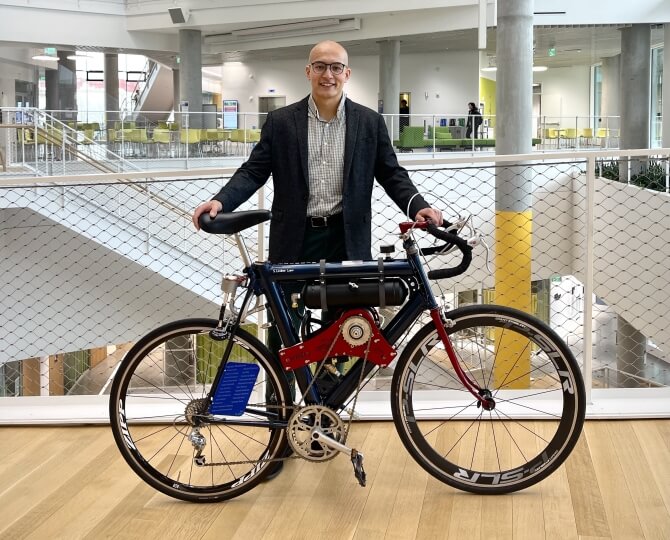Sebastian Lindner-Liaw, S.B. '23, constructed an assisted bicycle powered by compressed air instead of lithium-ion batteries as a senior capstone project.
Engineering Design Projects (ES 100), the capstone course at the Harvard John A. Paulson School of Engineering and Applied Sciences (SEAS), challenges seniors to engineer a creative solution to a real-world problem.
AirBike - Compressed-Air Assisted Bicycle
Sebastian Lindner-Liaw, S.B. ‘23, Mechanical Engineering
Advisor: Ansel Duff
Please give a brief summary of your project.
My thesis was designing and building a compressed air-assisted bicycle. Electric bicycles have recently seen a surge in popularity. However, the lithium-ion batteries that power them have high environmental and humanitarian costs. The goal of this project was to explore the feasibility of using compressed air as an alternative energy storage solution that retains the benefits of the e-bike without the moral and ethical concerns.
How did you come up with this idea for your final project?
I interned at Trek Bicycle over the summer in their E-systems division, and worked closely with a wide range of electric bicycles. I've always been passionate about bikes, as I think they are one of the best urban transportation solutions. I'm also passionate about sustainability and wanted to see if it would be possible to create an assisted bike with less of an environmental impact than traditional e-bikes.
Is there a real-world challenge that this project addresses?
Lithium-ion batteries require lithium as well as some rare earth metals such as cobalt. Lithium is extracted primarily from brine pools and open pit mining operations which can deplete local water supplies, contaminate groundwater, and produce toxic mining waste. Furthermore, the majority of the world's cobalt is mined in the Congo, where child labor and subhuman working conditions are commonplace. It is these harsh realities, often overlooked in the vision of an electrified utopian future, that motivate this project.
What was the timeline of your project?
This project was heavy on the design and build phases. Once I had decided on using compressed air, I spent the fall semester modeling the entire project in CAD. Being detailed and thorough in this phase would mean fewer headaches later on when I was building. Once I was satisfied, I began manufacturing parts and assembling subsystems over winter break and conducted final assemblies during the spring semester. In the last week before my presentation, I tested my build against the technical specifications I had laid out for myself at the beginning of the project.
What part of the project proved the most challenging?
Designing a functioning air system and packaging all the necessary components within the space constraints of the bicycle proved to be a fun challenge. I had to try a lot of different configurations and orientations to get each part to fit while still ensuring that they would function as intended.
What part of the project did you enjoy the most?
Manufacturing all of the pieces and seeing them come together to produce a bike was extremely rewarding. It was great to see the project make the jump from a three-dimensional model to a tangible, functioning product.
What did you learn, or skills did you gain, through this project?
I improved a lot of my hands-on manufacturing skills such as TIG welding, milling, turning on the lathe, and water jetting. I also became more comfortable designing a complete 3D CAD assembly and running simulations on it to ensure it would hold up to the rigors of the real world. Most importantly, I learned how to start with a problem statement and design a product that attempts to address the identified shortcoming.
Press Contact
Matt Goisman | mgoisman@g.harvard.edu
